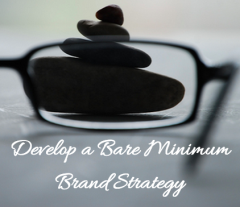In our short-term, shortsighted, gotta-get-it-done-now world, getting it done right often gets short shrift.
When it comes to brand strategy I see this all the time—expressed by clients large and small as some variation on, “We don’t have time for brand strategy… and there’s no money for consumer research… so let’s just get to the communications, all right already?”
Brand Strategy Takes…..Strategy
Yes, everybody likes to talk the brand strategy, but be honest, how many times have you had to start a marketing project, either as a consultant or a corporate player, without knowing all (or perhaps any) of the following:
- What’s the core brand position and how is it meaningfully different than the competition?
- Who are the prioritized audiences (I hate the word “targets,” although I still sometimes catch myself using it).
- Why and how—according to their own words and behaviors—does the brand matter to your customers and prospects. Functionally and emotionally?
- What is your succinctly stated, easy-to-understand, and believable-because-it’s-true brand promise based on that knowledge?
- What’s your distinctive brand personality and voice?
- Does your organization understand, and believe, your answers so they can deliver the brand experience that all of your marketing programs promise?
These are just a few of the strategic questions any brand needs to answer before deciding on and executing marketing tactics.
If the answers aren’t spelled out in a disciplined brand strategy document—and if you are being asked to execute a marketing program for which you will be held accountable—then it’s time to push back and at least establish the “branding bare minimum.”
I like to describe it as the “maximum minimum” (did I mention my love of oxymorons?)
It may not be the optimal process, but you will be much better off than if you just strategically wing it.
The Branding Bare Minimum
Ideally, there should be someone outside the brand organization to lead this “express” version of determining brand essentials.
I say this not (only) for the obvious reason that I am just such a consultant, but because brands need the objectivity and brutal honesty a good consultant can provide.
And for the remainder of this post, I’m going to speak as if directly to a marketer, but if you are a consultant, this is still what you should push to do or have done.
- Interview executive leadership. We’ll assume for this “discussion” that, as above, there is no appetite or budget for conducting formal research for a brand strategy. As shortsighted as that is, don’t let it defeat your discovery phase. Have your project leader proceed informally. Review and summarize general competitive information and materials. Do the same with any proprietary data analysis available from the brand. Then interview executive leadership one on one.
- Speak to key customers. Yes, I know… there’s no money for research. Your consultant or project leader should still speak to 10-12 key customers. This is required if you want your brand strategy to get past what your organization merely believes its brand to be and move on to how people actually experience it. Record the interviews so that you can deliver verbatim responses later in support of your conclusions.
- Conduct a branding workshop with the leadership team. It’s important to actively involve the larger leadership team (department heads, for examples,) in your brand strategy. This will provide you their knowledge while investing them in the outcome of the branding initiative. A workshop is also a great opportunity to get an organization out of its head and into its heart. Bridging the difficult gap between the rational and emotional understanding of the brand.
- Define your brand’s essence, benefits and unique personality. After engaging in discovery, it’s time to get down to definitions. What is the core truth of your brand? What’s its purpose? What are the brand promises you can truly deliver on (benefits, both rational and emotional)? And what personality accurately reflects your truth in the most relevant, appealing way to your customers and prospects?
Of course, it’s not enough to simply collect this disparate input—it needs to be distilled into simple, meaningful, actionable statements.
Brand Strategy Leads Tactics
Once you’ve established this bare minimum for brand strategy, you can more reliably proceed to marketing tactics.
Yes, the oft-quoted Jeff Bezos may be right when he opines that your brand is what people say about it when you’re not in the room.
Nonetheless, if you, and your entire organization, clearly know and own the simple truth of your brand before you ever send it into the big room that is the marketplace, you stand a much better chance of having the right people say the good things that will build your brand awareness, reputation, engagement … and your bottom line.
photo credit: pea gravel zen revisited via photopin
